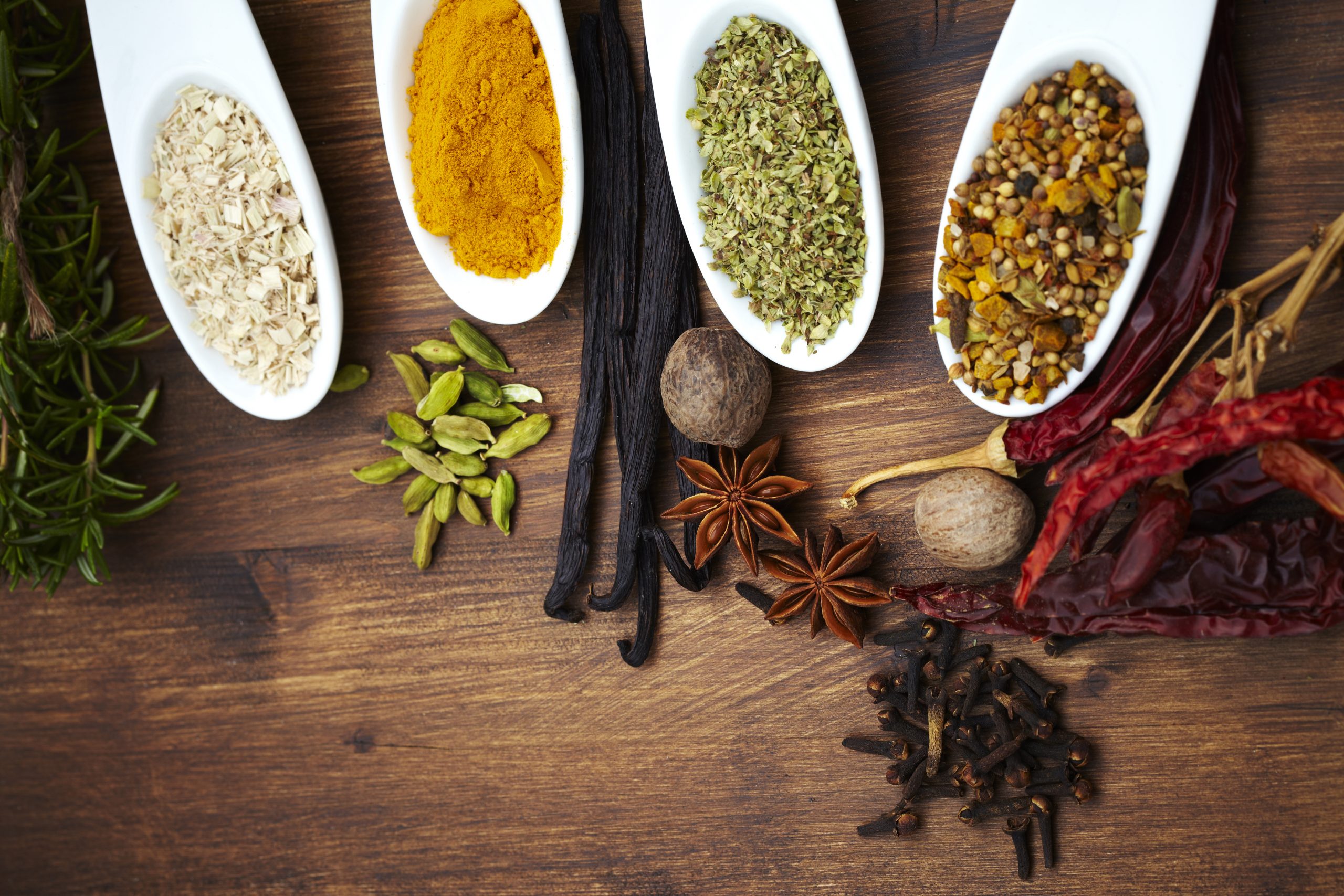Improve your health (and your cooking) by adding some of the world’s most nutritious and flavourful spices and herbs to your kitchen. Whole foods are healthy choices, but honestly, they can get boring. Transform them with the help of earthy, warm, and even sweet herbs and spices. Come discover which spices and herbs offer health benefits, and how to use them in your kitchen. It’s time to spice up your life!
What is the function of spices?
Spices may seem like a way to enhance flavour, but they are much more than that. What gives spices their strong flavours are plant compounds that offer health benefits. The health benefits of many spices and herbs are well-researched.
The 6 Healthiest Herbs and Spices, According to Research
- Cinnamon – its sweet taste disguises cinnamon’s strong powers as a blood sugar regulator and this spice has lipid-lowering potential, according to science.
- Cumin – traditionally used for gastrointestinal distress, newer research is focusing on the potential benefits of cumin in relieving symptoms associated with diabetes and heart disease.
- Garlic – a popular kitchen spice, research has shown garlic has excellent health-promoting and disease-preventing effects on common human diseases, through antioxidant, anti-inflammatory, and lipid-lowering properties.
- Ginger – one of the most studied spices with over 100 studies, ginger can improve nausea and vomiting during pregnancy, inflammation, metabolic syndromes, and digestive function.
- Rosemary – an aromatic shrub, rosemary is a functional flavour that’s been traditionally used in Mediterranean cuisine touted for its antioxidants (caffeic acid and rosmarinic acid), which have anti-inflammatory properties.
- Turmeric – a source of curcumin, flavonoids, quercetin, and polyphenols, this orange-hued root has been shown in research to have beneficial effects against inflammation, and oxidative stress.
What’s Better – Fresh or Dried Spices and Herbs?
Fresh is always best, however, the antioxidant capacity of dried herbs is still significant, notes a study. That’s great news for those who don’t live where fresh spices and herbs are readily available. In colder climates, such as Canada, one solution is to grow herbs inside as a fresh source of these functional flavours.
What is the best spice for flavour?
It all depends on what you’re craving. Some spices offer warmth to your dishes, such as turmeric or ginger. Others can offer sweetness, such as cinnamon. Herbs can both earthy flavours (thyme) or sweet (basil) to your salad dressings, vegetables, or tofu.
9 Common Spices & Best Ways to Use Them
Some of the most common spices, their flavour, and what best to pair them within the kitchen:
Basil (sweet) – eggplant, tomatoes, zucchini, garlic, rosemary, thyme, oregano.
Cinnamon (earthy, sweet) – apples, carrots, squash, allspice, nutmeg, cloves.
Coriander (earthy, peppery) – onions, tomatoes, potatoes, tofu, curry, chili powder, cumin.
Ginger (sweet, warm) – carrots, beets, citrus, cabbage, onions, tofu, garlic, oregano, cumin, turmeric.
Oregano (earthy) – artichokes, bell peppers, mushrooms, lemon, beans, bay leaves, thyme, ginger.
Paprika (sweet, warm) – cauliflower, broccoli, squash, tofu, garlic, cinnamon, cumin, chili powder.
Rosemary (earthy) – potatoes, mushrooms, peas, onions, beans, garlic, oregano, thyme, basil.
Thyme (earthy) – green beans, carrots, zucchini, cauliflower, lentils, oregano, rosemary.
Turmeric (bitter, peppery) – cauliflower, beans, lentils, tofu, garlic, ginger.
Learn How to Cook Healthy at our Holistic Culinary Workshops.
References
Ginger on human health: a comprehensive systematic review of 109 randomized controlled trials. Nutrients 2020 Jan; 12(1): 157.
Cumin: potential health benefits. Nutrition Today 2021 May; 56(3): 144-151.
Curcumin: total-scale analysis of the scientific literature. Molecules 2019 Apr;24(7): 1393.
Potential health benefits of garlic based on health intervention studies: a brief overview. Antioxidants (Basel) 2020 Jul; 9(7): 619.
Safety of cinnamon: an umbrella review of meta-analyses and systematic reviews of randomized clinical trials. Front Pharmacol 2022 Jan; 12:790901.
An evidence-based systematic review of rosemary (Rosmarinus ofiicinalis) by the Natural Standard Research Collaboration. Journal of Dietary Supplements 2010; 7(4):351-413.
Antioxidant capacity and phytochemical content of herbs and spices in dry, fresh and blended herb paste form. Int J Food Sci Nutr 2011 May; 62(3): 219-25.
Contributed by Allison Tannis
Known for her deliciously geeky words, Allison’s articles and books are read around the world by those curious about where to find the most delicious (and nutritious) places to stick their forks. More at allisontannis.com. Follow @deliciouslygeeky.

